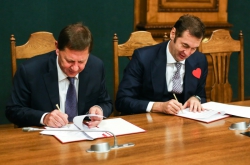Economy of the future
According to the Cities in Motion Index, compiled by the experts from IESE, one of the world’s best business schools, St. Petersburg is rated 103rd among 180 of the world’s “smartest” cities in regards to the development of their technologies and services.
The index analyzes almost 80 indicators in 10 categories: Governance, Urban Planning, Public Management, Technology, Environment, International Outreach, Social Cohesion, Mobility and Transport, Human Capital and Economy. This year’s leader is New York, with perfect ratings in seven out of ten categories. The second place was given to London, which excels in all but technology and social cohesion. Paris comes third, with great results in urban planning, transport and international outreach. St. Petersburg, meanwhile, shows 60% results in transport, governance, public management and environment, with other indicators being lower.
Nevertheless, Russia’s northern capital has every chance of getting into the index’s top-50, said St. Petersburg’s Governor Georgy Poltavchenko at the Forum. According to a report by McKinsey Global Institute, just 600 cities around the world will provide for 60% of the world’s GDP by 2025. It is not clear what these cities are, but the megacities of China, India and Latin America, where urban development is happening at a tremendous pace and a major population growth is expected, will surely be among them. Urbanization is happening in major Russian cities, too: in St. Petersburg, the GDP level has been growing for the past seven years; for the past six years, the city has experienced natural population growth; St. Petersburg holds 10% of Russia’s scientific resources. In addition, the amount of investments made into the city’s economy has increased by 12% in 2016. As the Governor explained, the city cannot ignore the development and integration of smart technologies, as they offer a way to provide the citizens with comfort and, therefore, further develop the city’s economy.

Georgy Poltavchenko
“Major investments have been made in IT; the city has the opportunity to secure a leading position in regards to adoption of digital technology. Authorities, passionate citizens and businesses must unite their efforts. The city already boasts some elements of smart technologies: public services are provided through multi-purpose centers both online and on-site, the “Our St. Petersburg” web-portal, the “SafeCity” video surveillance system. We are also creating a registry of ideas and tasks for the implementation of smart-city technologies, as proposed by citizens, businesses and the city administration. The numerous approaches to creating a smart city are all unique, but they have some things in common: ecology, utilities, transport, medicine, urban comfort, public spaces, personal safety, transparency of government,” – said Mr. Poltavchenko.
The city head added that when the Spatial Development Forum had first been implemented, it focused on the preservation of the city’s historic image in the conditions of modern development. Now, it is necessary to pay attention to the adoption of digital technologies.
Approaches
As ITMO’s Rector Vladimir Vasilyev, who was the plenary discussion’s moderator, pointed out, there are two ways to approach the development of a smart city. The first – centralized – would have all the decisions made by companies and other major players on the market.
“This begs the question: where should the big investments go? Towards creating massive sensor systems, information processing and Big Data, artificial intelligence or virtual and augmented reality? These systems require constant maintenance; besides, in the digital economy the time it takes for new product to appear is reduced to one to three years,” – explained Prof. Vasilyev.
The second approach would see the direction for development of urban smart technologies determined by the citizens and their behavior models. Data from their gadgets can be collected to create such models. This way, people themselves become sources of information for how their world functions, creating the Internet of People.

Vladimir Vasilyev
Internet of People includes the Internet of Things, too. Thus it is the concept of a massive system of biological and technological sensors that collect information not only about themselves, but their owners, as well: where they are, how they feel, etc. In theory, analysis of such data can help both create smart technologies and maintain their effectiveness.
Expert tips
At the plenary discussion, experts shared their advice on how smart-city technologies can be created and adopted in a cost-efficient way and with the most impact on the city.
Ksenia Mokrushina, Director of the Center for Urban Studies at School of Management SKOLKOVO
“Let startups create smart technology using open source data”
Ideas sent to developers “from upstairs” will never reflect the citizens’ needs a 100%, believes Ms. Mokrushina. Instead, city governments should take another approach: provide as much data as possible about the city infrastructure to startup developers. They are the ones who can offer services that are most relevant to customers and will make the city environment better.
Using open source data, it is possible to create services where citizens can, for instance, calculate their utility expenses, commute times, find creative outlets, etc. Thanks to that, they might make informed decisions about their daily life.
“The city will no longer need to develop a multitude of mobile applications. Instead, cities can motivate businesses and startups to develop these things. A city can say: “We’re giving you the data; you know the city better than us and, with your understanding of its issues, can develop the right solutions”. City governments can put out calls for developers and act as facilitators in the development of smart technologies. Innovations are no longer made behind the walls of technoparks and corporations – they come from the citizens themselves. The role of city authorities and universities is to motivate people to contribute to such work,” – said Ksenia Mokrushina.

Hovik Musayelyan, chairman of the committee for the development and implementation of the “Yerevan Smart City” program
“A smart city needs aware citizens”
The development of smart-city technologies needs people who are ready to do that. In fact, citizens need to be aware of the reasons why these technologies are needed and what benefits they may have. This means that, among other things, it is necessary for them to be sufficiently educated in the relevant fields, such as IT and logical thinking.
“We need to start with school education. For the past five years, chess has been a required part of the school curriculum in Armenia. We’ve also launched a pilot program for teaching high school students about microelectronics, programming and telecommunications in 11 schools of the republic. By 2025, we can implement this program in all of the nation’s schools,” – said Mr. Musayelyan.
He added that it is important to develop online services which citizens can use to express their needs in regards to urban infrastructure and adoption of smart technologies. City governments, for their part, can oversee such proposals and implement the most promising ones.
Dhiru Thadani, Vice President-Members of the Executive Committee at International Society of City and Regional Planners (ISOCARP)
“Funds need to go towards water treatment, not laying fiber-optic cable”
A lot of companies are interested in developing smart-city technologies, noted Mr. Thadani, because urban population is growing and, therefore, such ventures can be very profitable. They start selling equipment and technologies to make cities “smarter”, but not all of these initiatives succeed and billions of dollars are spent on nothing.
“The definition of what makes a city “smart” has changed several times over the past 15 years. I believe that there are three meanings that are usually conveyed by these words. The first is easy access to services, where all the necessary services are within a walking distance for all citizens. Another is the ability to move from one area to another and to be connected to the rest of the world through Wi-Fi and other means of communication. And, finally, it’s security. Like, for example, video surveillance. But for them to fulfill their function, they need people who would maintain them,” – commented the expert.

He emphasized that city governments need to pay attention not only to the development of urban infrastructures, but also to other “smart” aspects of a city. First of all, there needs to be a solution to the issue of food waste, which is caused by improper food distribution and lack of social awareness about sustainable consumption. Secondly, it is necessary to redefine “ecohouses”, as these are not houses that look modern and stylish, but are houses built from eco-friendly, locally-sourced materials. Thirdly, the lack of clean water will become a major concern in the future; it is thus necessary to direct resources towards cleaning up Russia’s rivers, not laying fiber-optic cables, says the expert. Cities also have to be beautiful in the most direct sense of the word. Each element of infrastructure can be both functional and pleasant to the eyes – like, for example, the Golden Gate Bridge in San Francisco.
And, finally, cities must be inclusive, which means that they must respect and fulfill the needs of all citizens, young and old, regardless of their race, culture, creed, sexual orientation, background or abilities.







